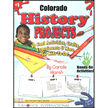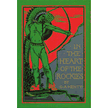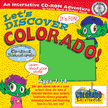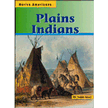COLORADO
 |
| www.pdclipart.org |
Covering most of the southern portion of the Rocky Mountains is the country's 38th state: Colorado. Only 15 years after being made a territory by Congress, Colorado (postal abbreviation: CO), attained statehood on August 1, 1876. This area had been explored by Europeans in the late 1500s, but no permanent settlements were established. In 1803, the eastern portion of what is now Colorado was part of the Louisiana Purchase, and the western portion was ceded to the U.S. in 1848 as part of the Treaty of Guadalupe Hidalgo after the Mexican-American War. Although we often mark the history of an area in terms of European discovery and settlement, this land had been inhabited for thousands of years by many different Plains Indians tribes, including the Utes, Cheyenne, Arapaho, Kiowas, Comanches, Pawnee, and the Sioux. (Research the history of Plains Indians in Colorado.)
Below is the flag of Colorado. It was adopted in 1911, the same year it was designed. The white stands for the snowcapped mountains, and the blue represents the bright blue skies. The red signifies the red-colored soil, while the yellow represents the sun.
 |
| www.pdclipart.org |
There are many tall peaks in Colorado, the tallest being Mount Elbert at 14,440 feet. Pike's Peak, famous during the gold rush in the late 1850s due to its proximity to where gold was found, is 14,115 feet tall. This mountain was named for Lieutenant Zebulon Pike who discovered it. He never did reach the summit. After gold was found, the slogan of those traveling to the area was "Pike's Peak or Bust." There was not a lot of gold found, but those early settlers who traveled west were able to buy up the land and then sell smaller lots to those who came later. One man who did this was General William H. Larimer. He planned a city east of Cherry Creek and named it Denver after the governor of the Kansas Territory, James Denver. There was a city on the other side of the South Platte River with whom there were tensions. One night, residents of both cities met on the bridge over the creek and, for the price of a barrel of whiskey, they allowed Denver to be the accepted name of the area. (Look at a map of Denver and see where Cherry Creek and the South Platte River are in relation to each other.) Denver became the state capital in 1876, the same year Colorado became a state.
CO is the 8th largest state in the U.S., and it is the 22nd most populous state as of 2010. The people who live here are called Coloradans. Some famous folks who have called Colorado home are "Aunt" Clara Brown who was the first African-American woman to settle here. Buffalo Bill Cody, of Buffalo Bill's Wild West Show, lived here for some time and is buried here as well. Chin Lin Sou was one of the first Chinese immigrants to Colorado and was also a very successful businessman. Horace Tabor was known as the Silver King after becoming very wealthy when silver was discovered years after the end of the gold rush. Little Raven was an Arapaho Indian Chief who struggled for peace with the whites. Margaret "Molly" Brown is famous for being a survivor of the Titanic, but she had an amazing life besides that. She fought for women's suffrage (CO was the second state to give women the vote) and gave much time and money to philanthropic pursuits. Actor Tim Allen, famous for being the voice of Buzz Lightyear in Disney's Toy Story, was born here. Boxer Jack Dempsey was born and raised in Colorado as well. Ross Lynch, who plays Austin in Disney's Austin and Ally, lives here. Author James Michener was a professor at the University of Northern Colorado and wrote a book about Colorado's history - Centennial.
Learn more about these Famous Coloradans and others. They are all very interesting.
Some other things that made their home in this area are Allosaurus, Apatosaurus, Brachiosaurus, Stegosaurus, Triceratops, and Tyrannosaurus Rex. Visitors to Colorado can visit the Dinosaur National Monument. The state fossil is the Stegosaurus.
 |
| www.pdclipart.org |
The state bird is the lark bunting, and the state animal is the Rocky Mountain Bighorn Sheep.
 | ||||
| www.pdclipart.org The state flower is the Rocky Mountain Columbine, and the state tree is the Colorado Blue Spruce. The name, Colorado, comes from the Spanish word for "color red," and either represents the color of the soil in some parts or the muddy appearance of the Colorado River. The state has two nicknames: Centennial State and Colorful Colorado. The motto is "Nothing Without Providence." For those planning to visit Colorado, there are four national parks and seven national monuments. There are hot-air balloon festivals throughout the state five months out of the year. There are also ski resorts open all year round, for skiing in the winter and other outdoor activities in the summer. Take the family to a dude ranch or go on a mine tour. Colorado's history is rich and its geography is quite varied, so there is an endless supply of things to do here. Check out some of these resources at Christian Book:
|
 | Colorado History Project Book, Grades K-8 By Carole Marsh / Gallopade International History projects include: creating a cartoon panel describing how our state name may have come about; dressing up as a famous explorer and recreating their main discovery and more! Grades K-8; ages 5-15. |
 |
Colorado My First Book, Grades K-5 By Gallopade International An "early bird" intro to basic state facts. Covers state basics such as state nickname, seal, song, bird, motto, flag, regions, industries, neighbors, and weather, plus an intro to state history, people and more. Includes: drawing, mazes, matching, coloring, and more! Reproducible. Available for all 50 states. Grades K-5; ages 5-10. |
![22691DF: Colorado State History In a Nutshell - PDF Download [Download] 22691DF: Colorado State History In a Nutshell - PDF Download [Download]](http://ag.christianbook.com/g/thumbnail/2/22691dft.gif) |
Colorado State History In a Nutshell - PDF Download [Download] By Cyndi Kinney & Judy Trout / Knowledge Box Central Get to know your home state! Comprehensive state history lapbook resources from Knowledge Box Central are designed so that children of all ages can study together. Explore state symbols, songs and landmarks, famous people, geographical regions, timelines of historical events, and more. The included state-specific study guide provides background information, history, and other factual information; this study guide is the same for both lapbook (Grades K-8) and lapbook journal (Grades 6-12) students, so that the parent only needs to go over the information once. This lapbook includes a list of all the supplies needed if following the included base guide. Blackline masters are provided for students to cut out and paste into their lapbook, while a photo of a finished lapbook provides a visual example. This Lapbook is structured for use with K-8th Grade Students. Get started on your lapbook immediately with this PDF Download. |
 |
Daily Life of the Plains Indian Village 1868 By Terry / Houghton Mifflin Harcourt Learn about how the Plains Indians lived in 1868, when Euro-American ideas began to influence Indian life more and more, though Native tradition still remained as the primary way of life. Full color photographs of ancient clothing and artifacts are mixed with modern Native Plains men, women and children illustrating how life looked back in 1868. The engaging text gives insight into the motivations, religion, customs, and homelife of the Plains people, as well as explanations of various traditions and objects. Vivid photography and interesting chapters bring to life the daily lives of a Plains family. 48 pages with glossary, index and timeline. Softcover. |


